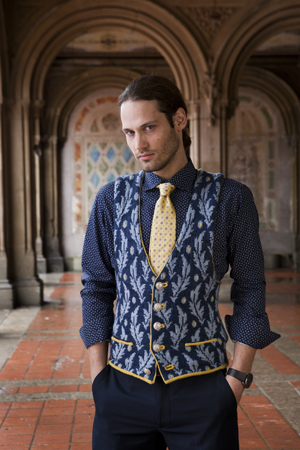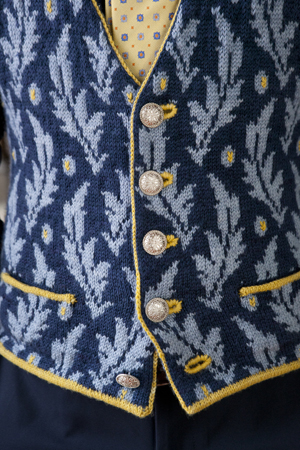Talking dandyism, operettas and the history of men’s fashion with the popular knitting personality.
By Christina Behnke
 While planning the Early Fall 2014 issue, our editors took note of small yet remarkable fashion trend on the scene: The modern-day dandy. Developing “The Modern Gentleman” menswear story in tribute, they went straight to the source, approaching male knitwear designers with decidedly dapper sensibilities. One such designer was Franklin Habit. A man of many hyphens, the writer-illustrator-history enthusiast-photographer has built a fan following through his blog, The Panopticon (http://the-panopticon.blogspot.com/). His design, Fitted Waistcoat, is quickly gaining popularity among male and female knitters alike. Habit, who is scheduled to teach this October at Vogue Knitting LIVE! Chicago, spoke to us about the history, fashion, and approach to fit that inform his design.
While planning the Early Fall 2014 issue, our editors took note of small yet remarkable fashion trend on the scene: The modern-day dandy. Developing “The Modern Gentleman” menswear story in tribute, they went straight to the source, approaching male knitwear designers with decidedly dapper sensibilities. One such designer was Franklin Habit. A man of many hyphens, the writer-illustrator-history enthusiast-photographer has built a fan following through his blog, The Panopticon (http://the-panopticon.blogspot.com/). His design, Fitted Waistcoat, is quickly gaining popularity among male and female knitters alike. Habit, who is scheduled to teach this October at Vogue Knitting LIVE! Chicago, spoke to us about the history, fashion, and approach to fit that inform his design.
Your waistcoat was an instant hit—though it has a decidedly vintage bent, it’s timeless as well. How did this project come about?
I got word that the issue was going to include a menswear story about the return of the male dandy, and was asked if I might have any interest in making a contribution. It took me under thirty seconds to send back a yes, with the addendum that I wanted to knit a waistcoat. The waistcoat is, for me, the emblem of dandy apparel. It gives the body a smooth line, it nips the waist, and it’s traditionally a locus for exuberant self-expression even if the rest of the ensemble is subdued.
Naming patterns isn’t part of the Vogue Knitting style guide, so our readers might be interested to know that you originally named it the Bunthorne Waistcoat. Is there any meaning behind this name?
There is. It’s from my favorite Gilbert and Sullivan operetta, Patience. You don’t see Patience performed much nowadays because the subject matter hasn’t aged well. It’s about the rivalry between a pair of rather drippy poets, both modeled on leading lights of the Aesthetic Movement. The Aesthetes believed (in part) that the creation of beauty should inform every part of daily life. The poet Bunthorne, who is described in the dramatis personae as a “fleshly” poet, lives every moment as performance art. Today, he’d be a hipster king who writes zine articles about craft brewing on an Underwood typewriter from the 1920s.
You mentioned in your pattern notes that “the cut is Edwardian, the motif High Victorian; the colors were inspired by a men’s fashion plate published […] during the Regency of Prince George.” Could you tell us how these styles of the past influenced your design?
The waistcoat is a garment with a very long history, and when I was looking at cut and proportions it seemed to me that the shape most suited to wear with modern clothing is the Edwardian. That was important, since I didn’t want to make something that would only work as a costume. The leaves and berries were inspired by wallpaper designs from the 1890s, when interestingly there was a vogue in textiles for bold, large-scale prints just as there has been in recent seasons. And the color palette was a happy find in a book about the Regency that I’ve owned for decades. There is one fashion plate full of men’s garments, and the combination of deep blue, grey-blue, and vivid yellow grabbed me right by the neck.
So the finished waistcoat references each of those eras, but it’s not from any one of them. It’s truly a product of now, not then.
Expanding on that, it’s interesting to think that as long as fashion has existed, so have trends. Can you offer some insight into the sartorial nuances of each of these eras?
The Regency Era is fundamental to the concept of the dandy. The proto-dandy, Beau Brummel, was a close friend and sartorial advisor to the Prince Regent of England. Claims that he “invented” the suit go a little too far, but he did lay down some rules and practices that have remained fundamental to elegant masculine dress. The Victorian era saw vivid color gradually drain out of men’s clothing (aside from statement pieces like waistcoats and neckties). And the Edwardian era, while mostly understated, was a high-water mark for precision tailoring and subtle elegance in combining colors and patterns.
Between this design and your hound’s tooth sweater from Vogue Knitting Winter 2012/13, it’s clear that you favor a more fitted menswear silhouette.
When I began knitting, it realized quickly that if I wanted to knit sweaters for myself I was going to have to design them, because I’m a non-standard size. The instructional sources I turned to all said the same thing: “The male torso is a cylinder.” No, excuse me, it is not. Men come in all shapes, just as women do. Few of us are cylindrical. None of us benefits from a tube of knitting that is designed to fit the chest and hangs like an empty trash bag around the waist with 8 inches of surplus fabric. Men of any shape benefit from body shaping to suit them, just as women do. And while the zero-ease fit of this waistcoat may not be for all figures, no dandy will ever put on a garment that is going to make him look bulky around the middle.
 You knit the waistcoat Lorna’s Laces Shepherd Sport. How did you like the yarn? Do you have any tips for knitting this project?
You knit the waistcoat Lorna’s Laces Shepherd Sport. How did you like the yarn? Do you have any tips for knitting this project?
My love affair with Lorna’s Laces goes back a long way, and Shepherd Sport may be my favorite. I love the hand, the smoothness, the perfect amount of softness versus durability, and the huge range of colors.
My chief tip for those who want to knit the waistcoat is to note that it is designed for zero ease, which is unusual. If you want to alter it to make it less closely fitted, add your extra fullness at the sides, under the arms.
Also, never button that lowest button. Never. Bad form.
How would you define a dandy? Think you have any dandyish qualities of your own?
A dandy is a man who considers his personal appearance to be an important part of his self-expression. His clothes may not be expensive or flashy, but they will have been chosen with care.
My own life is too ramshackle (knitting is a messy, sweaty occupation) to allow me to put on a waistcoat every day; but I do have dandyish impulses. I love good tailoring, I love beautiful fabric. I love well-made furnishings like cuff links and ties. And I believe strongly in dressing for the occasion. I don’t hold with the modern American idea that a “real” man never cares about how he looks, and should be seen primarily in drab colors and ratty sweatpants. Clothes don’t make a man, but they can make a man a slob. Not for me, thanks.
